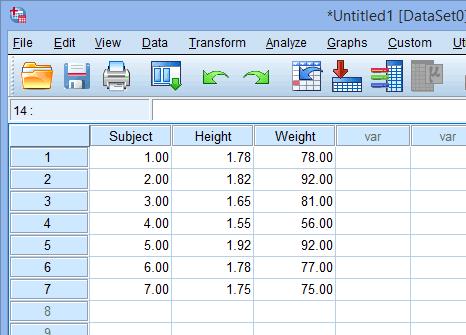Vollständige Liste der MS-DOS-Befehle
4168
30/11/2021

SPSS -Statistik
Variablen eingeben
If you do not have repeated measures, SPSS -Statistik treats each column as a separate variable.Somit geht jede Variable in eine separate Spalte. For example, if we had measured the height und weight of a group of individuals, the data in SPSS -Statistik would look like the following:
Published with written permission from SPSS -Statistik, IBM Corporation.
Das
Thema
Die Spalte wurde hinzugefügt, so dass klar ist, dass jede Person in eine separate Zeile platziert ist. However, SPSS -Statistik does not need you to enter this column, und it is mostly for you to be able to better visualize your data.Also, selbst wenn wir das ignoriert haben
Thema
Säule können wir sehen, dass eine Person 1 war.55 m groß und wog 56 kg, schaute mir das an
Höhe
und
Gewicht
Spalten jeweils.Wie man variable Spalten kennzeichnet
Arbeiten mit Variablen
führen.Um weitere Variablen hinzuzufügen, fügen Sie einfach weitere Spalten hinzu - eine Spalte pro Variable. Das only variation to this is discussed
später
in this führen when we have to enter repeated measures.
SPSS -Statistik
Definieren von getrennten Gruppen

So geben Sie Umfragedaten vom Forschungsinstrument/Fragebogen in MS Excel I Chi-Quadrat in SPSS I: https: // t ein.co/fg0kefe4yq über @youtube
— INFOKREEK Fri Jun 08 17:27:09 +0000 2018
Getrennte Gruppen werden häufiger als Zwischensubjektfaktoren oder unabhängige Gruppen bezeichnet. Dasy are groups where the individuals in each group are unique (i.e., niemand ist in mehr als einer Gruppe).In diesem Sinne könnten Sie die Gruppen "gegenseitig exklusiv" bezeichnen,.Ein häufiges Beispiel ist
when differentiating between gender. You want to label some of your individuals as female und others as male. To identify which subjects were males und which were females, you need to create a "grouping variable" in SPSS -Statistik. This is a separate column that includes information on which group a subject belongs to. We do this by labelling our groups numerically. For example, we label "males" as "1
" und "females" as "
2
".Durch Verwendung der
Wert
attribute we can label these numbers as representing males und females, respectively.Im Folgenden wird ein Beispiel angezeigt:
Published with written permission from SPSS -Statistik, IBM Corporation.
Wenn wir uns die Spalten links ansehen, können wir sehen, dass wir eine "Gruppierungsvariable" genannt "Geschlecht" erstellt haben, die zwei Kategorien hat: "
1
" und "
2
". Because we labelled the numbers using the Wert attribute we can use the Value Label Button to switch to the text version of the "grouping variable" categories. In this example, we can see that "1" und "2" are replaced by "
Männlich
" und "
Weiblich
", beziehungsweise. How to do this is explained in our führen on
Arbeiten mit Variablen
. You do not need to add text labels SPSS -Statistik will work fine without them but it can provide extra clarity when analysing your data (especially as text labels are often used in the output instead of the numbers this helps greatly). We can see in this example that the first three subjects were males und the last four subjects were females.Was ist, wenn Sie mehr als zwei Kategorien Ihrer "Gruppierungsvariablen" haben?Einfach, fügen Sie einfach weitere Zahlen hinzu, mit dem wir entsprechenden Textbezeichnungen empfehlen können.
